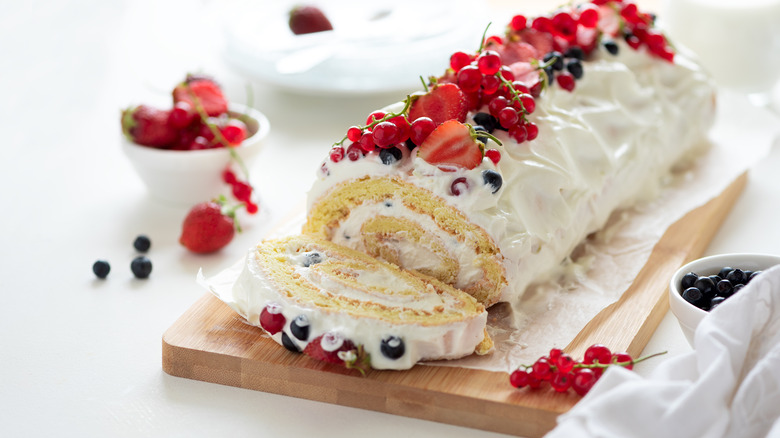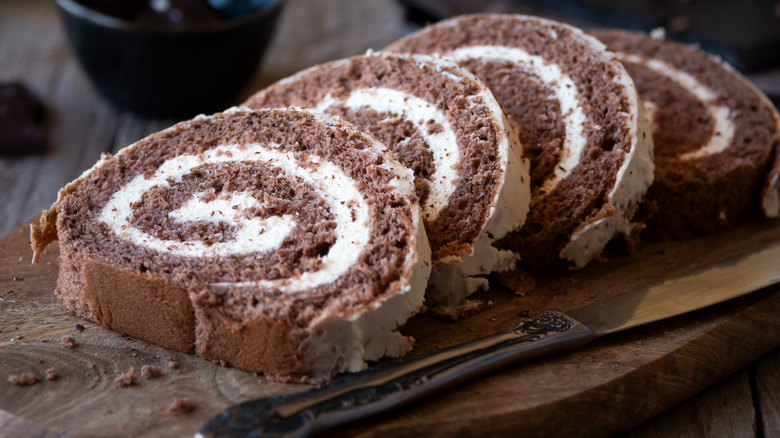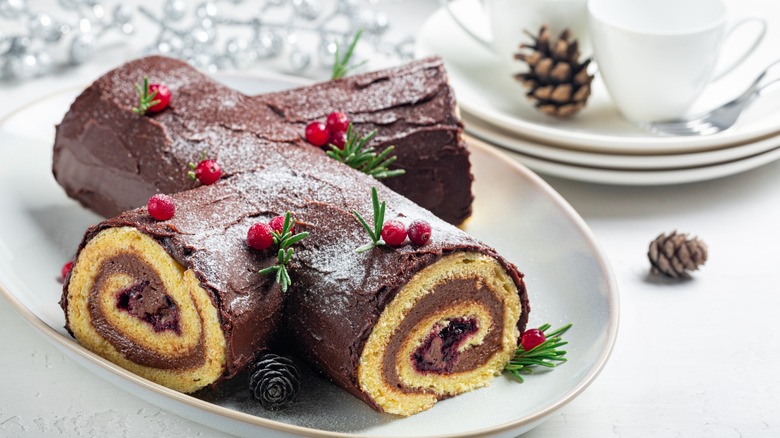The Key Ingredient To Making Sure Your Roulade Doesn't Crack
We may receive a commission on purchases made from links.
A roulade goes by a few different names, per Martha Stewart. Whether it's a humble jelly roll, Swiss roll, or the festive Bûche de Noël (aka yule log), these are all broad, thin sponge cakes that get topped with an icing or filling. Roll that into a cylinder and you've got a roulade. The best part is that the slices are intertwined coils of cake and filling. Roulades have become a holiday tradition in many cultures. It's a simple way to achieve something out of the ordinary.
Well, it's simple in theory. As with so many recipes, the simple things can be the toughest to master. Roulades are full of pitfalls. The ratio of filling to cake needs to be just right. The consistency of the filling can't be too wet or it'll sog out the cake. If the filling is too stiff, it won't roll.
All of those can contribute to the biggest roulade pitfall of all: cracking cake. A crack in your cake can quickly turn into a crevasse that no amount of icing can cover up. There's got to be a way to make these more flexible.
Gluten is key to roulades that won't crack
According to Healthline, gluten is a protein in some flours that gives bread its structure, allows a cream puff to puff, and helps cakes rise to airy, tender heights. As gluten hydrates and is mixed, the strands of protein unwind. As that dough or batter bakes, those strands reconnect, providing the scaffolding for a baked good's shape and texture. Strong gluten development is great for a baguette. That's not so for cake.
In most baked goods, the gluten development is limited. There's enough butter or oil to keep those protein strands from becoming too long. Those shortened strands make for a tender end result. That's where the term "shortening" comes from–to shorten the gluten, per Bob's Red Mill.
For cake that's destined for a roulade, bakers need to find a happy medium. Enough gluten to maintain the cake's integrity while it's rolled, but not so much that it isn't still tender. For vanilla roulade cakes like Confetti Party Roll Cake, that balance isn't difficult to achieve. Chocolate roulades, like a Chocolate and Vanilla Yule Log, aren't as simple.
Chocolate roulades are especially prone to cracking
Chocolate roulades are especially difficult, as cookbook author Stella Parks explains in Serious Eats. The chocolate acts like another form of shortening. Incorporating melted chocolate into a roulade batter will keep the gluten from doing its job. Adding cocoa powder seems like a great alternative but it sucks so much moisture from the batter, there's not enough to get the gluten activated.
To combat this, they begin by adding a higher proportion of flour and all the extra gluten that comes along. But all that extra gluten won't do any good if there isn't extra liquid. In this case, an additional egg and some water do the trick.
Even with a perfect cake formula, overcooking it will make it too brittle to roll. So, heed those baking times and rotate your pan to ensure even baking. A cold cake will probably crack when it's time to roll. So, Masterclass recommends giving the cake a head start and rolling it up while still warm but not filled. This way, it's doing some of the flexing while still pliable and it'll cool into a form that's closer to the final roulade's shape.
In the end, a roulade is a special cake often reserved for a special occasion. Give yourself time for a trial run of a Chocolate Maple Roulade or a Pumpkin Roll With Spiced Cream Cheese Filling before the big event. With these bits of advice, you'll be rocking and roulading in no time.


